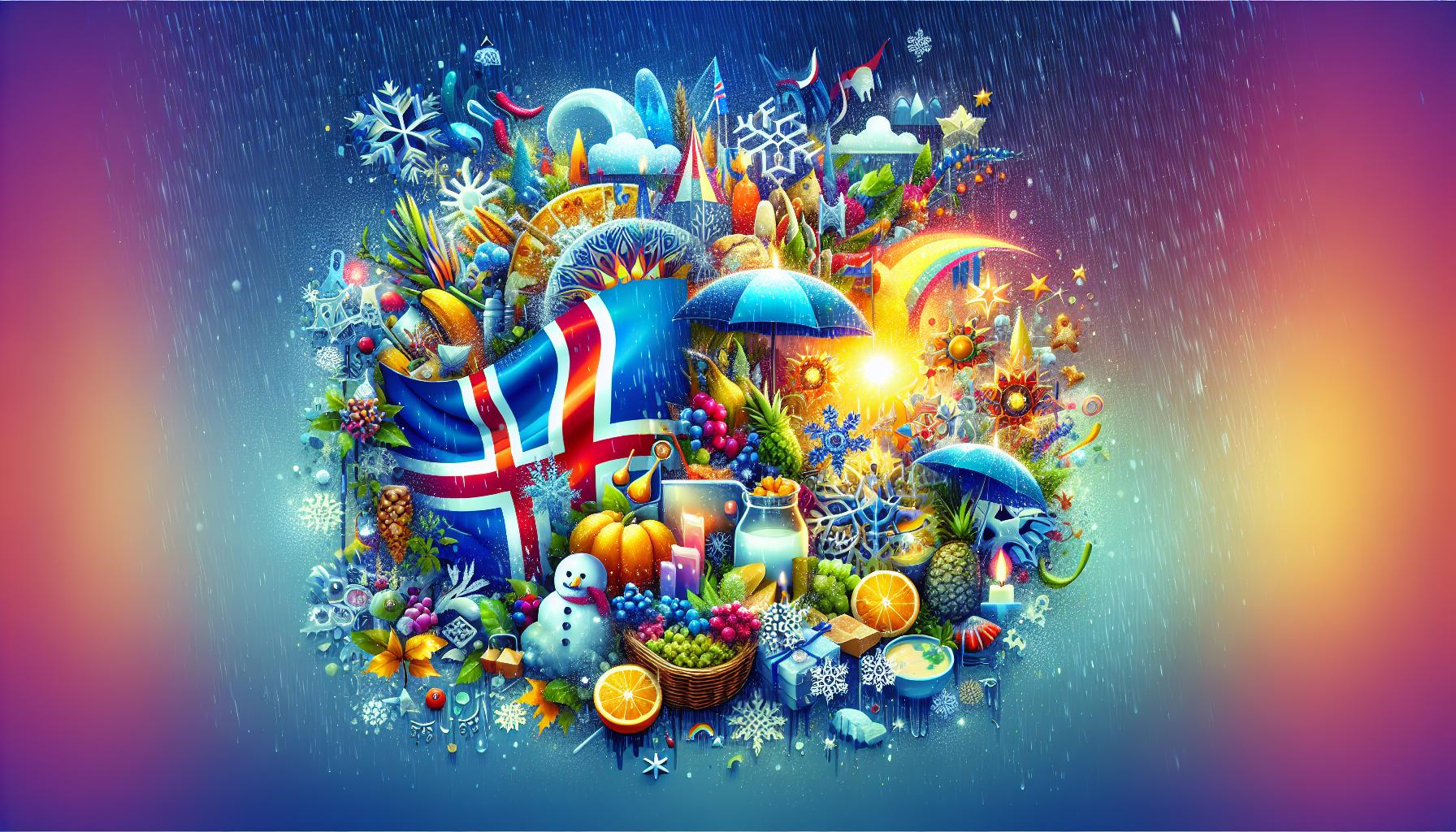Iceland’s weather can be as unpredictable as its stunning landscapes, leaving many travelers wondering about the frequency of rainfall in this Nordic paradise. Understanding the precipitation patterns is crucial for planning memorable adventures amidst breathtaking scenery. With an average precipitation of 82mm in March alone, being prepared for varied weather enhances your Icelandic experience while exploring this captivating island.
Understanding Iceland’s Unique Climate and Weather Variability

Iceland’s climate is as complex and varied as its stunning landscapes, often astonishing visitors with its dramatic shifts in weather. Known for its contrasts, the country experiences everything from sunshine to snow all in a single day, making it imperative for travelers and locals alike to stay well-informed about the prevailing weather conditions. Understanding this climate is essential not only for planning outdoor activities but also for appreciating the sheer dynamism of Icelandic nature.
Key Climate Characteristics
Situated just below the Arctic Circle, Iceland is influenced by both maritime and polar air masses, resulting in its unpredictable weather patterns. One of the defining features of Iceland’s climate is the Gulf Stream, which brings warmer temperatures, balancing the chilly north winds. The following are notable characteristics of Iceland’s climate:
- Changeability: The weather can shift rapidly, often within minutes, making it necessary for visitors to pack layers.
- Precipitation: Although it might not be as rainy as many expect, precipitation does occur frequently, especially in the western and southern regions.
- Temperature Fluctuations: Summers are cool, with average temperatures around 10-15°C (50-59°F), while winters can drop below freezing but are moderated by oceanic influences.
Understanding Rainfall Patterns
When considering the question, “does it rain a lot in Iceland?” it’s crucial to look at regional variations. Monthly precipitation can vary significantly, with the wettest months generally being September and October. Below is a simple table showcasing average monthly rainfall across key regions in Iceland:
| Month | Reykjavik (mm) | Akureryi (mm) | Egilsstadir (mm) |
|---|---|---|---|
| January | 34 | 43 | 24 |
| April | 37 | 45 | 22 |
| July | 59 | 75 | 49 |
| October | 98 | 84 | 70 |
Bear in mind that despite the overall precipitation readings, many visitors will attest that the stunning natural phenomena and breathtaking scenery often make the rain worth enduring. Planning your excursions while checking the weather forecasts can ensure that you make the most out of your adventures, whether you’re hiking in the rugged highlands or soaking in a geothermal pool.
By knowing what to expect and embracing the eclectic climate, you’re bound to gain a richer experience while exploring the wonders of Iceland. Always remember: no matter the weather, the land of fire and ice holds an abundance of treasures waiting to be discovered.
The Science Behind Precipitation: What Makes Iceland So Wet?

The weather in Iceland is as dynamic and unpredictable as its breathtaking landscapes, exhibiting a unique relationship with precipitation. Visitors often wonder, “Does it rain a lot in Iceland?” The answer is complex, as several meteorological factors contribute to the island’s reputation for wet weather. Situated just south of the Arctic Circle, Iceland experiences a blend of oceanic and polar influences that dictate its climate, resulting in significant moisture and precipitation patterns.
Geographical and Oceanic Influences
Iceland’s location in the North Atlantic Ocean plays a crucial role in its climate. The country is situated along the path of the North Atlantic Current, which brings warmer air from the tropics. This warm air collides with the cold Arctic air masses, creating a perfect recipe for precipitation in the form of rain and snow. The mountainous terrain also exacerbates these conditions; as moist air moves inland, it is forced upwards, cooling and condensing into clouds and precipitation.
Factors contributing to Iceland’s wet weather include:
- Latitude: Being located close to the Arctic Circle influences not just temperatures but also changes in weather patterns.
- Oceanic currents: The warm North Atlantic Current and cold polar currents create contrasting air masses.
- Topography: The country’s rugged landscape, featuring numerous mountains, causes orographic lifting that enhances precipitation.
Seasonal Variations and Patterns
While it is common to associate Iceland with rain, understanding the seasonal variations in precipitation is essential. The country generally experiences higher levels of rainfall during the summer months, particularly from June to August, with an average of 60-90 mm per month. During winter, snow becomes more prevalent, especially in northern regions, where precipitation can drop to around 30-50 mm monthly.
To illustrate these patterns, consider the average monthly precipitation for Reykjavik and Akureyri, two of Iceland’s major cities, shown in the таблица below:
| Month | Reykjavik (mm) | Akureyri (mm) |
|---|---|---|
| January | 50 | 40 |
| February | 40 | 30 |
| March | 50 | 40 |
| June | 80 | 60 |
| August | 90 | 70 |
| December | 60 | 50 |
These variations highlight that while Iceland may be wet, the specifics can vary widely based on location and season. Understanding these patterns can enhance your travel experience, allowing you to pack appropriately and plan adventures that embrace, rather than shy away from, the island’s unique climate.
Experiencing the Rain: A Local’s Perspective on Icelandic Weather

The weather in Iceland is as dynamic as its stunning natural landscapes, often characterized by quick shifts between sunshine and rain, sometimes within minutes. Local residents have learned to embrace this unpredictable climate, viewing the frequent precipitation not as a nuisance but as a vital part of the island’s unique ecosystem. Understanding the rhythm of Icelandic weather, particularly rainfall, offers an incredible opportunity to experience the land in all its moods, enriching any visit to this remarkable country.
The Dance of Weather in Iceland
Iceland’s weather is heavily influenced by its location along the North Atlantic Ocean, making it susceptible to dramatic fluctuations. The phrase “if you don’t like the weather, wait five minutes” truly reflects local wisdom. Precipitation is common, particularly during the late fall and winter months, but it can rain at any time of the year. Here’s what locals have learned about navigating these weather patterns:
- Always Carry a Raincoat: A lightweight, waterproof jacket is essential. Even if the morning starts off sunny, being prepared ensures you won’t be caught off guard.
- Layer Your Clothing: The temperature can drop significantly with rain, so wearing layers allows you to adjust as needed.
- Plan for Indoor Activities: If forecasts predict heavy rain, consider exploring local museums or geothermal spas as perfect respite from the weather.
- Embrace the Rain: Some of Iceland’s most stunning scenery, like waterfalls, are at their most magnificent after a good rain. Don’t let a drizzle deter you from exploring!
A Local’s Favorite Rainy Day Activities
While some may seek shelter from the rain, locals often find joy in the downpour. Here’s a look at popular activities that thrive despite the weather:
| Activity | Description |
|---|---|
| Foss Waterfall Tours | Witness the power of nature at iconic waterfalls, best viewed during or after rain. |
| Geothermal Spas | Relax in natural hot springs, which are even more enjoyable when it’s cool and drizzly outside. |
| Local Cafés | Enjoy cozy coffee shops and sample traditional Icelandic pastries while watching the rain. |
In summary, understanding the rainfall patterns in Iceland enhances the travel experience, revealing the country’s charm in every season. For anyone planning a trip, keeping in mind that frequent rain can be an opportunity rather than a hindrance helps in making the most of every moment spent in this beautiful region. So pack your bags, embrace the weather, and discover the true spirit of Iceland!
Seasonal Shifts: How Iceland’s Rain Patterns Change Throughout the Year

The ever-changing rain patterns in Iceland are nothing short of mesmerizing, particularly when considering their seasonal fluctuations. Iceland’s unique geographical position and its complex interplay of ocean currents, winds, and topography create a dynamic climate. This results in distinctive weather patterns throughout the year, making it essential to understand how precipitation varies by season to fully appreciate the beauty and challenges of Icelandic weather.
Winter: The Often Overlooked Rainy Season
In Iceland, winter is often associated with cold temperatures and snow, but precipitation doesn’t take a back seat during the colder months. Surprisingly, rain is frequent, especially in the coastal areas. The mountains act as natural barriers, catching moisture-laden winds, resulting in significant rainfall at lower elevations and periods of snowfall at higher altitudes.
- December to February: Average temperatures hover around -1°C to 4°C (30°F to 39°F), with precipitation levels ranging between 60-120 mm (2.4-4.7 inches) monthly.
- Location Matters: Coastal regions like Reykjavik often experience rain, while inland areas might see more snow, emphasizing the diverse weather across the island.
Spring: A Transition to Lighter Showers
As spring approaches, the weather begins to transition. March and April see a mix of rain and budding sunshine, with days gradually lengthening. This time is crucial for agriculture and the early blooming of Icelandic flora, though it can still be quite unpredictable.
| Month | Average Precipitation (mm) | Average Temperature (°C) |
|---|---|---|
| March | 50-90 | 0 to 5 |
| April | 30-70 | 1 to 7 |
| May | 40-60 | 3 to 10 |
Summer: The Season of Light Rain
In summer, particularly from June to August, visitors to Iceland can expect a different precipitation pattern. While the temperatures rise and daylight lasts nearly 24 hours, the islands face lighter showers. This is often the ideal time for outdoor activities, though brief rain spells can still surprise hikers and adventurers.
- June: Expect around 40-80 mm (1.6-3.1 inches) of rain as the summer solstice approaches, with average temperatures ranging between 10°C and 14°C (50°F-57°F).
- July and August: The warmest months typically see slightly drier weather, although sporadic downpours can still occur.
Autumn: The Return of the Rains
As summer transitions to autumn, rain returns with a flourish. September and October often deliver more substantial storms, making preparation essential for travelers during these months. The weather can shift rapidly, presenting both lush landscapes and dramatic skies.
Understanding these seasonal shifts in rain patterns is crucial for anyone planning to experience the unique climate of Iceland. By being aware of what to expect in terms of precipitation—whether it be the lighter rains of summer or the heavier showers of autumn—travelers can better equip themselves for their adventures and fully enjoy the breathtaking beauty of this island nation.
Dressing for the Deluge: Essential Gear for Adventuring in Iceland’s Rain

Iceland, often dubbed the “land of fire and ice,” is equally known for its unpredictable weather, with rain being a regular visitor throughout the year. Understanding the saying, “There’s no such thing as bad weather, only inappropriate clothing,” is crucial when planning your adventure in this stunning yet often wet landscape. Having the right gear can mean the difference between a delightful exploration of waterfalls and hiking trails or a damp and uncomfortable experience. Here are some helpful tips for dressing and preparing for the downpours often found in this unique country.
Essential Clothing Layering
Layering is key to staying dry and comfortable in Iceland’s frequently rainy climate. The three-layer system—base, insulation, and outer—will provide the flexibility to adapt to varying weather conditions.
- Base Layer: Opt for moisture-wicking materials like merino wool or synthetic fabrics. Avoid cotton, as it absorbs moisture and can leave you feeling cold.
- Insulation Layer: A lightweight fleece or down jacket will help retain body heat when temperatures drop, making it essential even on rainy days.
- Outer Layer: Invest in a high-quality, waterproof and breathable jacket. Look for features like adjustable hoods, cuffs, and ventilation zippers to enhance comfort.
Footwear Matters
The right footwear can keep your feet dry and supported on Iceland’s rugged terrain. Waterproof hiking boots with good ankle support are highly recommended. Make sure they are well-fitted and broken in before your trip to prevent blisters.
Accessories for Full Coverage
It’s wise to supplement your main attire with essential accessories that protect against the elements:
- Waterproof Pants: Choose breathable and waterproof pants that can be worn over your regular clothing.
- Hats and Gloves: A waterproof hat is vital to keep rain out of your face, while insulated gloves retain warmth and dexterity.
- Gaiters: If you plan on trekking through wet or muddy trails, gaiters can protect your lower legs and keep water out of your boots.
In conclusion, being well-prepared with the right gear is essential for enjoying the mesmerizing landscapes of Iceland despite its notorious rainfall. Following the guidelines from “Does It Rain a Lot in Iceland: Precipitation & Weather Patterns” and understanding what to wear will enhance your adventure, enabling you to relish the vibrant green moss-covered cliffs, roaring waterfalls, and majestic geysers, rain or shine.
Beyond the Rain: Discovering Iceland’s Breathtaking Landscapes and Activities
Iceland, often referred to as the land of fire and ice, offers a mesmerizing array of landscapes that captivate visitors despite its reputation for rainy weather. The diverse geography ranges from volcanic craters and bubbling hot springs to cascading waterfalls and expansive glaciers. While precipitation is a common aspect of Iceland’s climate, it only enhances the beauty of its rugged terrains, making them more vibrant and alive.
Explore the Unique Landscapes
The interplay of rain, sun, and the climatic conditions in Iceland leads to breathtaking landscapes that vary dramatically across the island. Prepare yourself to witness:
- Glacial Lagoons: Jokulsarlon is a prime example where floating icebergs create a surreal scene that photographers dream of.
- Volcanic Caves: The haunting beauty of caves formed by volcanic activity can be explored, revealing unique geological formations.
- Waterfalls: Iconic spots like Gullfoss and Skogafoss roar with energy, particularly after rain when they surge with even more power.
- Lava Fields: The stark landscapes dotted with ancient lava formations tell the story of Iceland’s fiery eruptions.
These elements combine to create a dynamic environment, where each season reveals a different aspect of Iceland’s natural beauty. The rain may fall frequently, but it also contributes to the lush greenery and stunning waterfalls that define the landscape.
Outdoor Activities in Diverse Weather
Iceland’s unpredictable weather patterns don’t stifle adventure; instead, they enhance it. Embrace the rain while exploring various activities that allow you to enjoy the island’s beauty, such as:
- Hiking: Trails like the Laugavegur hike offer stunning vistas that rival any other in the world, rewarding you with breathtaking views regardless of occasional rain.
- Whale Watching: The coastal waters around Akureyri are prime locations for spotting majestic whales, especially in the cooler months.
- Hot Springs: Relax in natural hot springs like the Blue Lagoon, where the contrast of warmth amid rain is an unforgettable experience.
- Photography Tours: Joining a guided tour can help you capture stunning images of landscapes that many miss in the midst of unpredictable weather.
Ultimately, while the query “Does It Rain a Lot in Iceland: Precipitation & Weather Patterns” might give some pause, it’s essential to remember that these elements only enhance the enchanting landscapes and adventures available. Prepare adequately, embrace the elements, and you will be rewarded with experiences that will linger in your memories long after your visit.
The Joy of Rainy Days: Finding Beauty in Iceland’s Wet Weather
Imagine standing on a rugged cliff, the Atlantic winds whispering through your hair, as sheets of rain create a shimmering veil over the volcanic landscapes, turning them into a living canvas of greens and browns. In Iceland, where precipitation is a common visitor, every rainy day brings a unique kind of beauty, transforming the scenery into something ethereal. The secret to appreciating this weather lies in embracing it rather than resisting its presence. Here’s how you can find joy and adventure even on the grayest of days.
Embracing the Elements
Rain in Iceland is a natural part of its stunning ecosystem. The country is known for its unpredictable weather patterns, but rather than seeing rain as an inconvenience, consider it an opportunity. Here are some ways to embrace Iceland’s wet weather:
- Nature Walks: Rain paves the way for vibrant flora, so take to the trails. The wet conditions often amplify the colors of the moss-covered rocks and lush greenery, creating a stunning backdrop for photography.
- Waterfalls in Their Glory: Rainfall invigorates Iceland’s famed waterfalls like Seljalandsfoss and Gullfoss, allowing them to flow with renewed vigor and creating spectacular misty rainbows.
- Hot Springs Retreat: What’s better than soaking in a geothermal hot spring as rain falls around you? The Blue Lagoon and other natural hot springs provide the perfect sanctuary where you can relax amid Iceland’s dramatic weather.
Capturing Unique Moments
The interplay of rain and light in Iceland offers unparalleled opportunities for photographers and nature lovers alike. On a rainy day, the clouds create soft diffused light, which can enhance the natural colors of landscapes, making them appear vivid and otherworldly. Here are practical tips for capturing these moments:
- Golden Hour Magic: Just before the rain stops, the sun often peeks out again. This ‘golden hour’ can yield breathtaking photographs with dramatic contrasts between dark skies and brilliant landscapes.
- Use of Umbrellas and Rain Jackets: Equip yourself with waterproof gear to stay dry while ensuring that you don’t miss out on the scene unfolding around you.
A Taste of Icelandic Culture
Rainy days are also a fantastic opportunity to immerse yourself in Iceland’s rich cultural offerings. With the weather pushing you indoors, take the time to savor local cuisine or engage in artistic pursuits. Here are some suggestions:
- Indulge in Icelandic Cuisine: Warm up with a bowl of traditional lamb soup or freshly baked rye bread while enjoying a cozy café atmosphere.
- Art Galleries and Museums: Explore Reykjavik’s thriving arts scene by visiting galleries and museums, such as the National Museum of Iceland, where you can discover the nation’s rich history and heritage.
Weather can change at a moment’s notice in Iceland, but rather than allowing frequent rain to dampen your spirits, let it enhance your experience. The unpredictable nature of “Does It Rain a Lot in Iceland: Precipitation & Weather Patterns” can lead to some of the most memorable moments of your journey—each dish, each landscape, and each interaction colored by the lush vibrancy that rain brings.
Local Legends and Folklore: How Rain Shapes Icelandic Culture and Stories
In Iceland, the frequent rains are not merely a climatic phenomenon; they are a source of inspiration for centuries of folklore that permeate the island’s culture. Stories of elves, trolls, and hidden people often intertwine with the wet, misty landscapes, reflecting the dramatic weather patterns that shape everyday life. The presence of rain is so significant that it has become intertwined with local legends, influencing how inhabitants perceive the natural world around them.
Rain and the Realm of Spirits
Icelandic folklore is rich with tales that reflect the belief in nature spirits, which are said to dwell in the country’s varied topography—mountains, valleys, and rivers. For many, rain is viewed as a sign of the presence of these beings, particularly elves. According to legend, when it starts to drizzle, it’s often attributed to the elves holding their celebrations. Rain also serves as a harbinger of change, associated with the blessings of fertility and growth. In many rural communities, people leave small offerings, such as bread or coins, at the base of trees or stones believed to be the homes of these spirits, hoping for good fortune in return.
Cultural Reflections in Stories
The unpredictable nature of Icelandic weather has influenced storytelling traditions. The old saying, “If you don’t like the weather, wait five minutes,” captures the ever-changing conditions, which are often weaved into the fabric of local tales. For example, there are stories about characters who venture out, only to encounter mystical rainstorms that transport them to other realms or reveal hidden truths. These narratives create a deep connection between the environment and the local identity, emphasizing the resilience and adaptability of the Icelandic people.
To further understand this relationship between rain and culture, consider how various elements of Icelandic life are celebrated during rainy days. Traditional events, festivals, and even family gatherings often incorporate themes of rain or storm—offering a chance to reflect on the cycles of life influenced by the weather.
Practical Insights: Embracing the Rain
For visitors eager to experience the enchantment of Iceland’s rain-soaked landscapes, here are some actionable tips to fully appreciate the local culture intertwined with its weather patterns:
- Dress appropriately in layers and waterproof gear to stay comfortable while exploring the outdoors.
- Participate in local folklore tours that focus on stories related to the rain and its impact on Icelandic life.
- Engage with local artisans who incorporate elements of nature, including rain, into their crafts and storytelling.
- Seek shelter in cozy cafés or hot springs during rain showers to engage in conversations about local legends.
These practices not only enhance the travel experience but also provide a deeper understanding of how rain shapes Icelandic culture and its rich tapestry of stories, creating a unique blend of nature and narrative that captivates every visitor.
Q&A
Does It Rain a Lot in Iceland: Precipitation & Weather Patterns?
Yes, it does rain quite a bit in Iceland, with annual precipitation averaging around 700-1,500 mm depending on the region. The weather can be unpredictable, with rain often mixed with snow, particularly in winter.
Iceland’s unique geography contributes to these precipitation levels. Coastal areas, like Reykjavik, experience milder climates, while the interior sees more extreme weather. Be prepared for spontaneous weather changes and consider checking local forecasts when planning outdoor activities.
What are the seasonal weather patterns in Iceland?
Iceland’s weather is characterized by four distinct seasons: cold winters with frequent snowfall, cool summers with long daylight hours, and transitional seasons of spring and autumn that can be wet.
Winter (December to February) can be harsh, but it’s also when the Northern Lights are visible. Summer (June to August) brings more pleasant temperatures, often ranging from 10°C to 15°C (50°F to 59°F), making it ideal for hiking and exploring. Learn about other seasonal activities to enjoy during your visit.
Can I visit Iceland during the rainy season?
Absolutely, visiting during the rainy season can be a unique experience filled with lush landscapes and spectacular waterfalls. Keep in mind that rain does not deter adventurers, as Iceland is stunning in all weather conditions.
Packing waterproof gear and flexible plans are advisable. Many popular attractions, like the Golden Circle, remain accessible year-round, and the scenery takes on a vibrant, fresh feel after a rain shower.
Why does Iceland have so much rain?
Iceland experiences heavy rainfall primarily due to its geographical location and the influence of the North Atlantic Ocean. The island’s unique terrain leads to orographic lifting, where moist air is pushed up by mountains, causing precipitation.
This phenomenon is especially noticeable in the south and west of the island, where the environment is verdant and teeming with life. Weather fronts coming from the ocean can bring sudden showers, so being prepared for rain is essential when exploring Iceland.
How does the amount of rain in Iceland compare to other countries?
When comparing precipitation, Iceland’s rainfall is moderate. For instance, cities like Bergen in Norway receive nearly double the rainfall annually, while desert regions see significantly less.
This varying climate fosters a rich ecosystem. In contrast, Iceland’s rainfall supports dramatic landscapes, such as its many waterfalls and geysers. It’s a land of contrasts, where rain feeds the earth’s raw beauty.
What should I pack for a trip to Iceland considering the rain?
Packing for Iceland requires consideration of the frequent rain and varying temperatures. Essential items include a waterproof jacket, sturdy hiking boots, and thermal layers.
Bringing a good umbrella and quick-dry clothing will enhance your comfort while exploring. Many locals suggest layering to adapt to the ever-changing weather conditions easily. Exploring Iceland’s iconic landmarks like Seljalandsfoss will be enjoyable, even in drizzle.
When is the best time to visit Iceland to avoid rain?
While no time guarantees avoidance of rain in Iceland, the late spring to early summer (May to June) sees relatively lower precipitation and milder temperatures, making it a popular choice.
This period allows for extended daylight hours, perfect for enjoying outdoor adventures and sightseeing. Many travelers find this a sweet spot when nature bursts into bloom, providing exceptional photography opportunities amidst stunning landscapes.
The Way Forward
Iceland’s weather is as dynamic as its breathtaking landscapes, offering a unique blend of beauty and unpredictability. While it’s true that precipitation can be frequent, especially in the form of rain or snow, each season has its own charm. For instance, April brings a mix of warmer temperatures and occasional snow, making it a time of transition where you can experience both winter’s remnants and the first hints of spring [1[1].
In summer, particularly June and August, temperatures can be pleasantly mild, ranging from 6°C to an inviting 25°C (43°F to 77°F), though sudden rain showers can interrupt those sunny moments [2[2][3[3]. As you plan your adventure, remember that Iceland’s weather at any time of year offers the chance for awe-inspiring moments – like watching a rainbow arch over a lush valley after a brief rain, or witnessing the sun breaking through clouds to cast a golden glow on a glacier.
So whether you’re wandering through the charming streets of Reykjavik or exploring the majestic fjords, embracing the unpredictable weather is part of the Icelandic experience. Pack your rain jacket, but also your sense of adventure, and prepare for a journey that promises memorable encounters with nature and local culture. Let the allure of the Land of Fire and Ice inspire your next great adventure, where every shift in weather can reveal something new and extraordinary.






